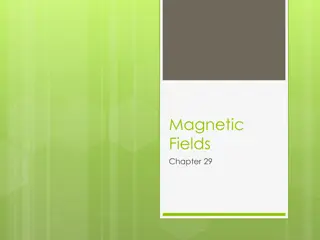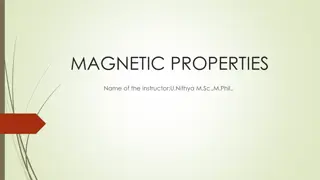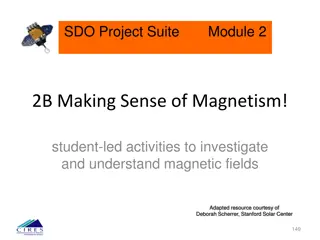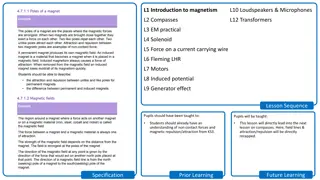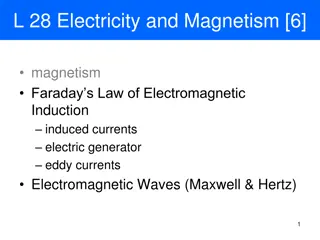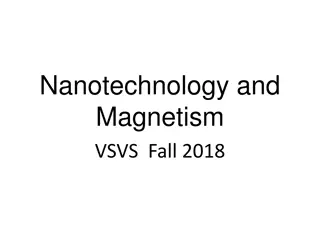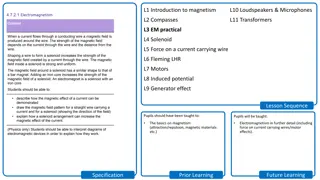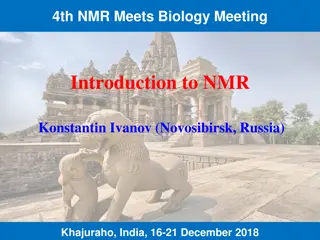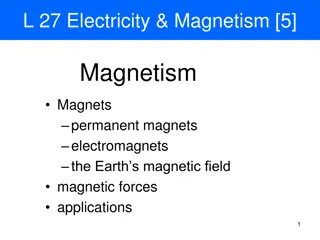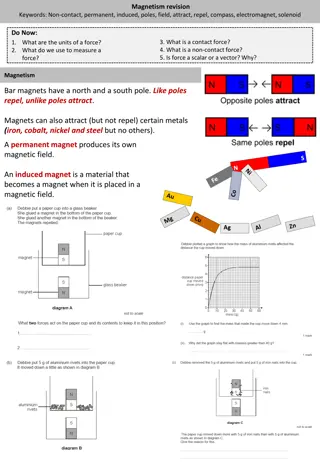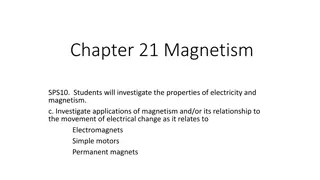Understanding Magnetism: Forces, Fields, and Applications
Explore the fascinating realm of magnetism in Physics as you delve into topics such as forces on charged particles, path of particles in magnetic fields, torque on current loops, and Earth's magnetic field alignment. Learn about the force on straight wires and electric charges in magnetic fields, and discover how magnetic fields work with charged particles. Test your knowledge with clicker questions and unravel the dynamics of a proton in a cyclotron.
Download Presentation

Please find below an Image/Link to download the presentation.
The content on the website is provided AS IS for your information and personal use only. It may not be sold, licensed, or shared on other websites without obtaining consent from the author. Download presentation by click this link. If you encounter any issues during the download, it is possible that the publisher has removed the file from their server.
E N D
Presentation Transcript
Magnetism II Physics 2415 Lecture 15 Michael Fowler, UVa
Todays Topics Force on a charged particle moving in a magnetic field Path of a charged particle moving in a magnetic field Torque on a current loop in a magnetic field, magnetic dipole moment
Earths Magnetic Field is approximately that of a bar magnet almost (but not quite) aligned with the axis of rotation. The S pole is under the Arctic so a compass N pole points appropriately. At the Earth s surface, the magnetic field is approximately horizontal only near the equator. The inclination to the horizontal is the dip angle: 90 at the magnetic poles.
Force on Straight Wire Carrying Current in Constant Magnetic Field It is well established experimentally that F = Id B is true for any angle between the wire increment and the constant field direction. In particular, a wire parallel to the field will feel zero force. This equation fixes the unit of magnetic field: for F in Newtons, I amps, B is in Teslas.
Force on an Electric Charge Moving in a Magnetic Field We ve seen that the force on an element of current in a wire in a magnetic field is: dF = Id B The current I is a line density C/m of charge moving at speed v, where I = v. Let s denote the total charge in a particular by Q = d . Then Qv = vd = Id , and the force on the current element is seen to be a force on this moving charge, . F Qv = d B
Clicker Question A charged particle moving through a magnetic field feels a force . The rate at which the magnetic field does work on the particle depends on: A. Only the magnetic field strength and the charge B. It depends also on the velocity and angle C. None of the above: the work done by the magnetic field is always zero. = F Qv B
Clicker Answer A charged particle moving through a magnetic field feels a force . The rate at which the magnetic field does work on the particle is zero. In a time dt, the particle moves and the work done F ds Qv = 0. v B v = = F Qv B = ds vdt B ds = B vdt = 0 Qv since The force is always perpendicular to the direction of motion, so does no work.
Proton in a Cyclotron A proton in a uniform magnetic field, with initial velocity perpendicular to the field, will circle at constant speed in a plane perpendicular to the field. The equation of motion is mv r . v F 2 = evB magnetic field perp into screen
Proton in a Cyclotron The equation of motion is mv . v = 2/ r evB F from which the time of one revolution 2 / T r v = = m eB 2 / and this is independent of the radius of the orbit! This independence made the cyclotron accelerator possible. magn field perp into screen
Proton in a Cyclotron The two D s are hollow D- shaped metal boxes, open along the straight part. The circling protons go back and forth. The oscillator alternates the relative voltages of the D s, so as a proton goes from one to the other it is attracted and accelerates, going into a larger, faster circle but with the same period each time. . If the proton reaches relativistic speeds, its mass increases and the circling time changes.
Charged Particle in Magnetic Field If the initial velocity is not perpendicular to the field, the motion in constant field will be circular plus a constant velocity parallel to the field a helix. If the field is becoming stronger in the direction of motion, the helix gets tighter, and finally reverses. This is a magnetic mirror, used to confine plasmas in prototype fusion reactors. . The slope of the field lines gives a backward component to the magnetic force.
Large-Scale Magnetic Confinement The van Allen radiation belts are filled with charged particles moving between two magnetic mirrors created by the Earth s magnetic field. The outer belt is mostly electrons, the inner one mostly protons.
Torque on a Current Loop b . Take first an axb rectangular loop, horizontal, in a uniform magnetic field with field lines parallel to the end sides of the loop. The forces on the other sides are vertical as shown, with magnitude I B = IaB, and torque about the axis: /2 IaBb IaBb = + a loop area A = ab b/2 = = /2 IabB IAB end view
Current Loop at an Angle The loop has a magnetic field resembling that of a short bar magnet, we define the direction of the loop area as that of the semi equivalent bar magnet. The torque is sin IAB = = IA = . A current out b/2 current in = , B IA = IA is the magnetic dipole moment, in exact analogy with the electric . = end view p E




